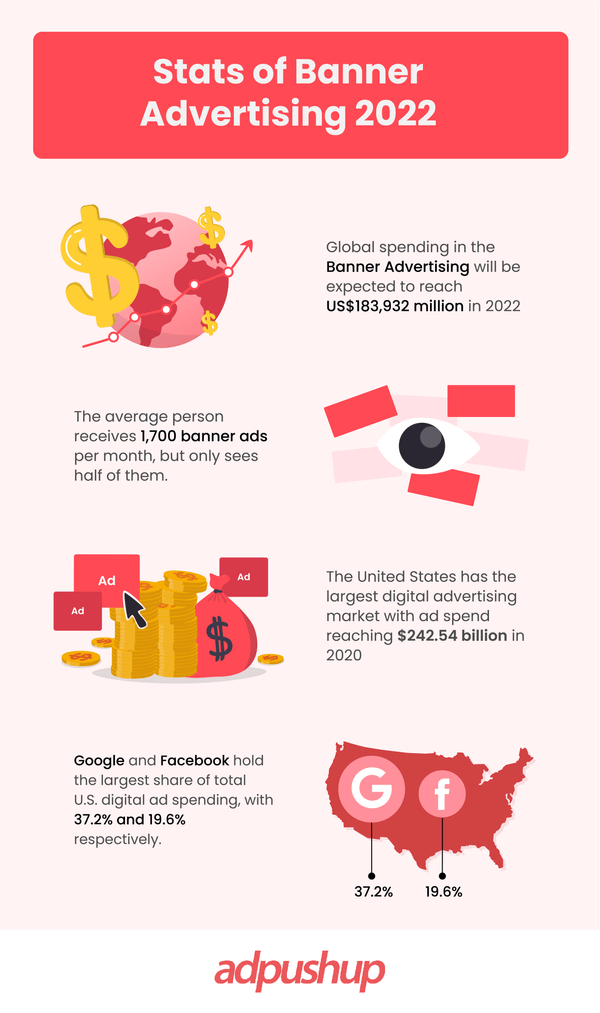Discover the world of in banner video ads and learn how to leverage their power in digital marketing. Get started with our comprehensive guide.
Exploring the dynamic realm of digital advertising, one encounters a compelling innovation known as in banner video ads. These ads represent a fusion of captivating video content and strategically placed banner advertisements, which can bring publishers’ monetization efforts to new heights.
In fact, video ads are the future of advertising. HubSpot research states that more than 50% of consumers want to see videos— more than any other type of content. While advertisers and marketers have known about this opportunity, publishers are still a little skeptical about video ads. However, many video ad types are perfectly designed to benefit publishers – one of which is in-banner video ads.
What Are In-Banner Video Ads?
In-banner video ads are short videos (with no sound) or GIFs embedded into a typical display ad (or banner ad) slot. These videos are usually HTML5 creatives designed from the thumbnail image and a text description of limited characters.
In-banner video ads deliver a dynamic ad viewing experience, and they can incorporate animated or interactive elements to increase engagement. Hence, they are much more interactive than traditional display ads.
Some examples include:
- In-page video
- Video interstitial
- Rewarded video
- In-display
- In-feed video
Before we dive into the types of In-banner video ads, here are a few interesting banner ads statistics:

Types of In Banner Video Ads
These ads are mostly in three types:
Click to play
First in the list, click-to-play ads are the creatives that are displayed as a static image, and the video plays only when the user clicks on it.
Autoplay with no sound
The video starts playing automatically without sound unless the user clicks on the creative. Given that videos of this nature play automatically, users are often caught unprepared.
It remains uncertain whether they have adjusted their device’s volume to an extremely high or low setting. This is precisely why autoplay functionality, accompanied by muted sound, is implemented.
Hover to play
In this type of in-banner video ad, the video plays once the user hovers over the creative. Yes, a user does not have to click on the video, hovering the cursor on the creative does the trick.
Learn more:
What are Outstream Video Ads and How to Get Started With Them?
How to Use In Banner Ads on Google Ad Manager?
In-banner video ads are served via direct campaigns in Google Ad Manager. The ad creatives are sent by advertisers, so publishers don’t need to do much. However, there are few pointers to remember:
- The video should not be longer than 2 minutes.
- Ad creatives should have a replay button
- Audio must play once the user clicks on the creatives
- The video should have a start, mute, and stop button
- In hover to play banner ads, the video should start playing after 2 seconds of hovering
- While selecting the size of the creative, choose 300x250v.
How to Set Up Set Up In-Banner Video Ads in Google Ad Manager?
Want to set up in-banner video ads in Google Ad Manager? Here are a few simple steps:
- Go to Google Ad Manager home page
- Select ‘Protections’ > New Protection
- Select ‘Ad content’
- Enter a name for protection
- Choose the retargeting capabilities for inventories
- Scroll down to find ‘opt-ins’ on the right side of screen
- Click on opt-ins to allow GAM to receive requests for in-banner video ads
Pros & Cons of In-Banner Video Advertising:
Starting with Pros
| Better User Experience | When visitors click on the video ads, they engage with the ads. These video ads don’t appear like an outright promotion. Instead, they appear on the top search results or the sidebar, and it’s entirely up to the user if they want to click on the ad. Hence, these video ads are less disruptive. |
| No video player required | Unlike in-stream video ads, in-banner video ads don’t require video players or video content. Instead, the advertisers provide GIFs or short videos, and the ads are directly played over the banner ad slots. Hence, publishers don’t need to depend on video player vendors, which, in turn, reduces the complexities of running video ads. |
| Higher click-through rates | In-banner video ads have better engagement records than the standard display banners. Though these ads are more expensive and time-consuming to create, their ability to effectively narrate a story drives more ad clicks. |
| No video length limitation | Compared to the in-stream video ads with strict duration limits, these ads can be as long as the marketers want them to be, which gives them a lot of flexibility. There is a storage limit, though – the file size should not exceed 500 MB. |
Cons
| Lower demand | Since browsers often restrict auto-play video ads, in-banner ads are not very favorable. Compared to other video formats, these video ads have lower demand. As per the latest Confiant Demand Quality Report, the rate of in-banner video ad impressions has constantly fallen. |
| Poor loading speed | In-banner videos prove heavy on websites, which impacts a website’s loading speed. Furthermore, since there’s no video player involved, the creative takes longer to load. |
Best Practices for In-Banner Video Advertising
If you want to give these video ads a try, here are a few practical tips to get you started:
Mobile optimized ads
Since people typically consume content on their mobile phones, thus it is recommended to experiment with different mobile ads size.
Short videos
Yes, there’s no duration limit for these video ads, but a shorter video would have the most negligible impact on your page and a better user experience.
User-friendly implementation
When implementing video ads, it’s crucial to consider the needs of the users, their experience with your website, and also the demands of the advertisers.
Where advertisers want their videos to be implemented on the main parts of the page, you should make sure that the ads don’t hinder a user’s on-page experience.
Run A/B Experiment
Since the one-size-fits-all approach never works in ad tech, you should continue exploring better options. We suggest running A/B experiment and exploring various audiences and different ad creatives to find what works best for your website.
In Closing
Publishers can leverage in-banner video creatives to utilize sequential messaging and extend video reach outside the in-stream environment.
However, switching from traditional display ads to these video ads can be daunting. So, publishers need to ensure they have all the resources to make that process successful.
If you’re ready to try your hand at in-banner video ads and see how it speeds up your ad revenue goals, then why not book a complimentary demo call with us?
We at AdPushup leverage programmatic advertising and advanced ad technology to maximize your yield on web inventory with the new video ad units.
Frequently Asked Questions
In-banner video ads are GIFs or short videos embedded into a display ad slot.
Below are some tips for in-banner ads:
1. Place the banner ads correctly
2. Make texts instantly readable
3. Use animation
4. Use standard banner sizes
5. Ensure user-friendly implementation
Some of the benefit of using these video ads are as follows:
1. Better user experience
2. No video player required
3. Higher click-through rate
4. No video length limitation

Deepak has a keen eye for detail and a deep understanding of the ad tech landscape. Whether it’s through in-depth articles, thought-provoking insights, or compelling storytelling, he’s dedicated to helping people navigate the complex world of ad tech with the simplicity of his words.








1 Comment
Thanks for sharing this, its very useful for me keep it up Thanks